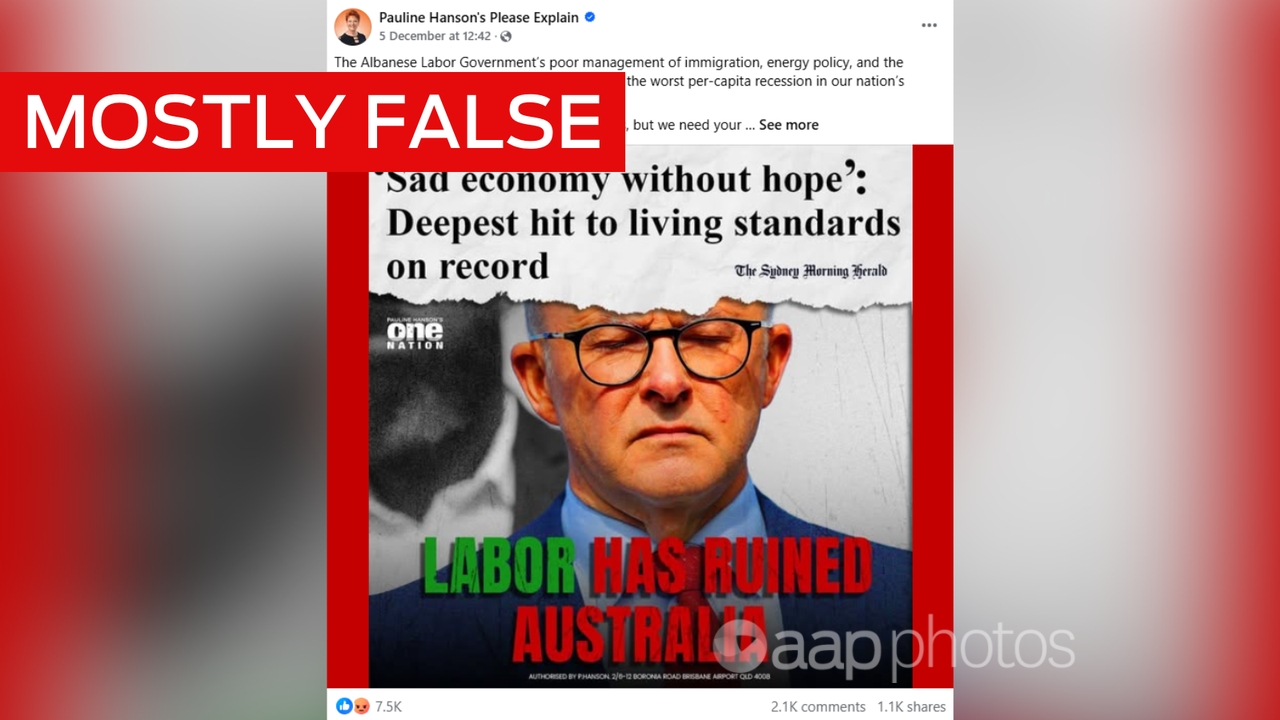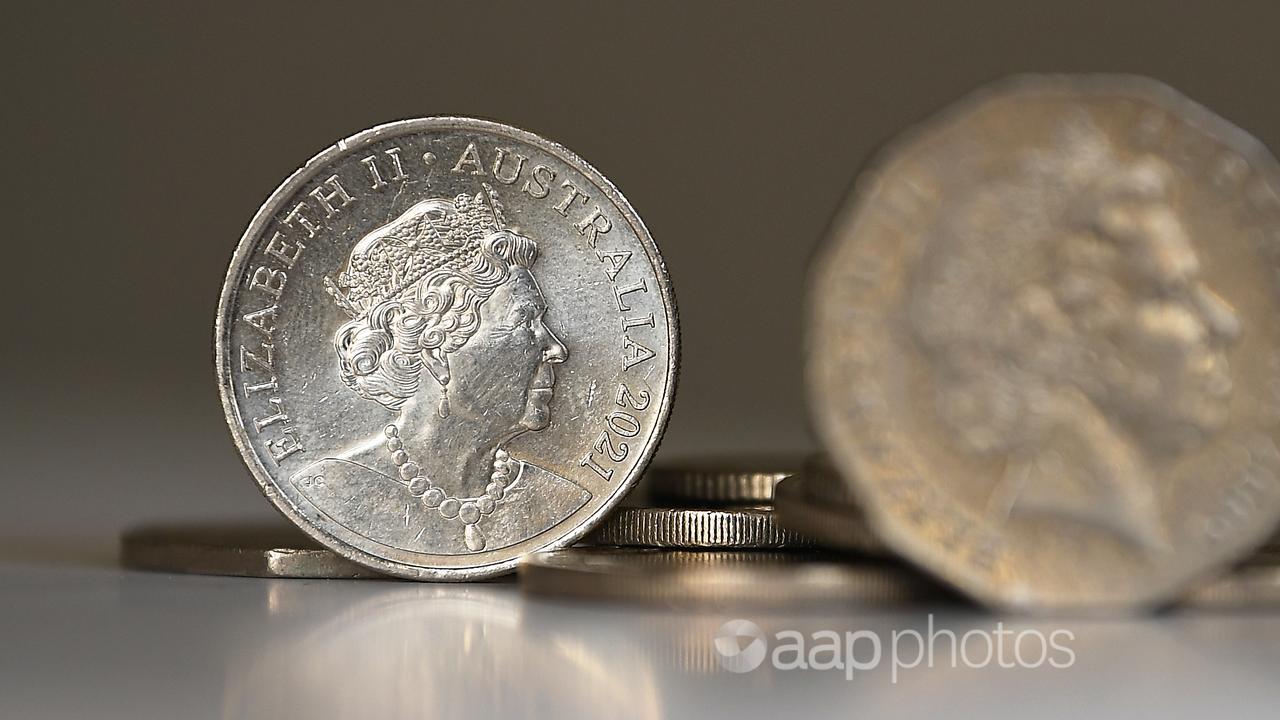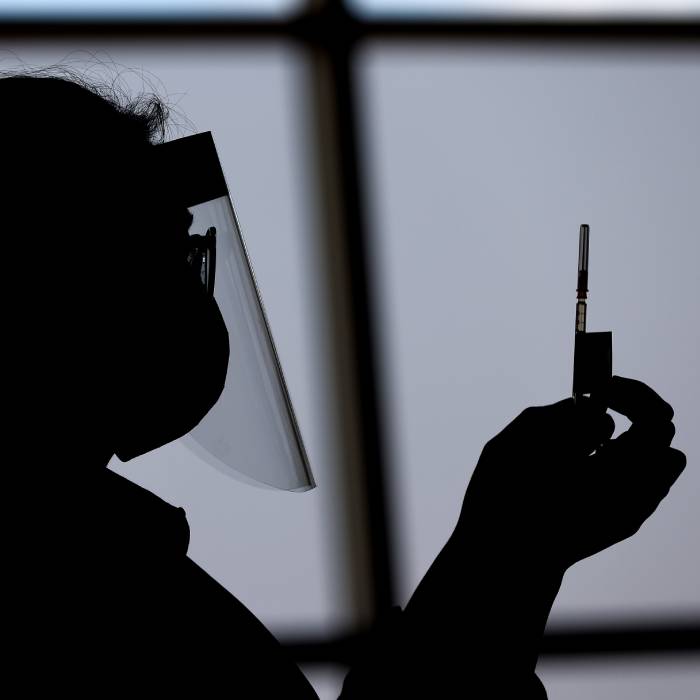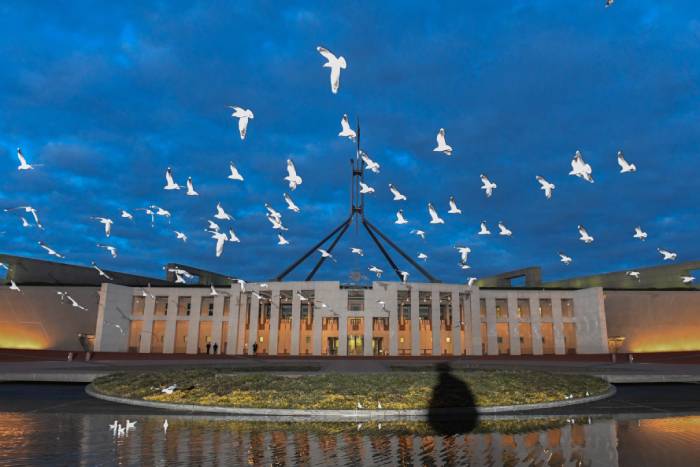AAP FACTCHECK – Senator Pauline Hanson has claimed Australia is experiencing its worst per capita recession in history, but economic figures stretching back more than a century show things have been worse before.
The country recently recorded the seventh consecutive quarter of decline in per capita gross domestic product (GDP). This is the longest period of per capita recession in the Australian Bureau of Statistics (ABS) data series, which began in 1973.
However, several per capita recessions in that period recorded a deeper dip in per capita GDP, resulting in steep rises to unemployment.
Other sources show a number of longer and deeper per capita recessions in the early 20th and late 19th century.
Ms Hanson made the claim in a Facebook post, captioned: “The Albanese Labor Government’s poor management of immigration, energy policy, and the economy has left Australians suffering through the worst per-capita recession in our nation’s history.”

It includes a quote from a Sydney Morning Herald article in which EY chief economist Cherelle Murphy said the latest GDP figures showed a “sad economy without much hope”.
A spokesperson for Ms Hanson said she was referring to the number of consecutive quarters of negative per capita GDP growth.
The spokesperson referenced a news.com.au graph showing the country was experiencing its longest period of per capita economic decline since the early 1980s, as well as a September article by the Australian Institute of Company Directors that reported GDP per capita had then fallen for six consecutive quarters, which it claimed was the longest on record, though comparable with contractions in the early 1980s and 1990s.
During an interview on Sky News Australia in December, shadow treasurer Angus Taylor made a similar claim, saying the country had never before seen seven consecutive quarters of contraction in GDP per capita (three minutes 48 seconds).
The ABS released the latest economic data in December, covering the September 2024 quarter.

GDP is the monetary value of all goods and services a country produces in a set period of time.
GDP per capita divides that gross figure by the population, which helps reveal whether the economy is growing or shrinking relative to the size of its population.
The latest ABS figures showed Australia’s GDP – a common measure of a country’s economic activity – increased by 0.3 per cent in the quarter and 0.8 per cent in the year to September, the lowest rate since the December 2020 quarter during the COVID-19 pandemic.
On a per capita basis, GDP shrank by 0.3 per cent, with a 1.5 per cent decline in the year to September.
Detailed figures accompanying the release showed the country also recorded seven consecutive quarters of GDP decline per capita and eight quarters of decline in the last nine.
But is this the “worst per capita recession” in Australia’s history?
ABS figures extend to December 1973, and while there hasn’t been a per capita recession that’s lasted quite as long within that timeline, there have been deeper recessions.
Since December 2022, when this latest decline began, GDP per capita has dropped a cumulative 2.1 per cent, from $24,355 to $23,834.
However, in the June 2020 quarter during COVID there was a 6.9 per cent drop in per capita GDP – by far the deepest drop in the ABS figures.
By contrast, the largest recent decline was 0.5 per cent in the June 2024 quarter.
Between March 1990 and December 1991, GDP per capita dropped by 3 per cent.
And there was a 6.2 per cent decline between September 1981 ($12,631) and June 1983 ($11,842).
The 1970s also featured some short, sharp drops in per capita GDP, with a 3.1 per cent drop between June and December 1975, preceded by a 2.8 per cent drop between December 1973 and June 1974.
The year 1973 isn't the end of Australia's economic record, however. Multiple economics historians told AAP FactCheck Ms Hanson's claim was false and referenced figures extending back to the 1800s.
Claire Wright, a business historian at the University of Technology Sydney, is the author of a book on Australia's economic history.
She said there have been several recessions magnitudes "worse" on a per capita basis since federation in 1901.
While the duration of a recession is important, Dr Wright said, "duration on its own does not tell us very much about the relative impact of a recession.
"Something can be very bad for a short period, or a little bad for a long period.
"When comparing recessions, as Senator Hanson has done, what matters is the cumulative effect, the total size of the impact on the economy."

Drawing on figures from The Cambridge Economic History of Australia, Dr Wright pointed to four periods in which GDP per capita fell by 3.5 per cent or more in a single year: 1907-1908 (9.2 per cent), 1929-1930 (5.9 per cent), 1945-1946 (5.3 per cent) and 1982-1983 (3.5 per cent).
She also said that the recession of the early 1990s was about comparable to the present situation.
Economic history expert Jeff Borland told AAP FactCheck Ms Hanson's claim was "certainly not a correct statement".
Professor Borland also referenced figures from The Cambridge Economic History of Australia, which showed real GDP per capita fell by 20 per cent between 1929 and 1931.
Real GDP takes into account price changes and seasonal influences.
"So the Great Depression saw a much more severe decline in per capita GDP," he said.
Macroeconomist Jakob Madsen told AAP FactCheck the current per capita recession wasn't as bad as previous downturns, including in the 1890s and 1930s.
While predating Australia's federation, a 2001 paper published by the Reserve Bank of Australia claimed the country's worst recession occurred in the 1890s.
During this period real GDP fell by 17 per cent when a property bubble burst and 54 of the country's 64 banking institutions closed by 1893.
In terms of ranking the "suffering", as Ms Hanson put it, experienced during different recessions, Professor Madsen said unemployment was a good indicator of "economic distress".
ABS figures from 1978 show unemployment has remained historically low, at four per cent in November 2024, compared with peaks of 11.1 per cent in 1992 and 10.4 per cent in 1983.
The Verdict
Mostly false – The claim is mostly inaccurate but includes minor elements of truth.
AAP FactCheck is an accredited member of the International Fact-Checking Network. To keep up with our latest fact checks, follow us on Facebook, Twitter and Instagram.
In the story "FC Hanson Recession" sent at: 08/01/2025 20:29.
Paragraphs 32 to 35 removed due to an error in the displaying of data on the MeasuringWorth.com website.
This is a corrected repeat.
All information, text and images included on the AAP Websites is for personal use only and may not be re-written, copied, re-sold or re-distributed, framed, linked, shared onto social media or otherwise used whether for compensation of any kind or not, unless you have the prior written permission of AAP. For more information, please refer to our standard terms and conditions.

















